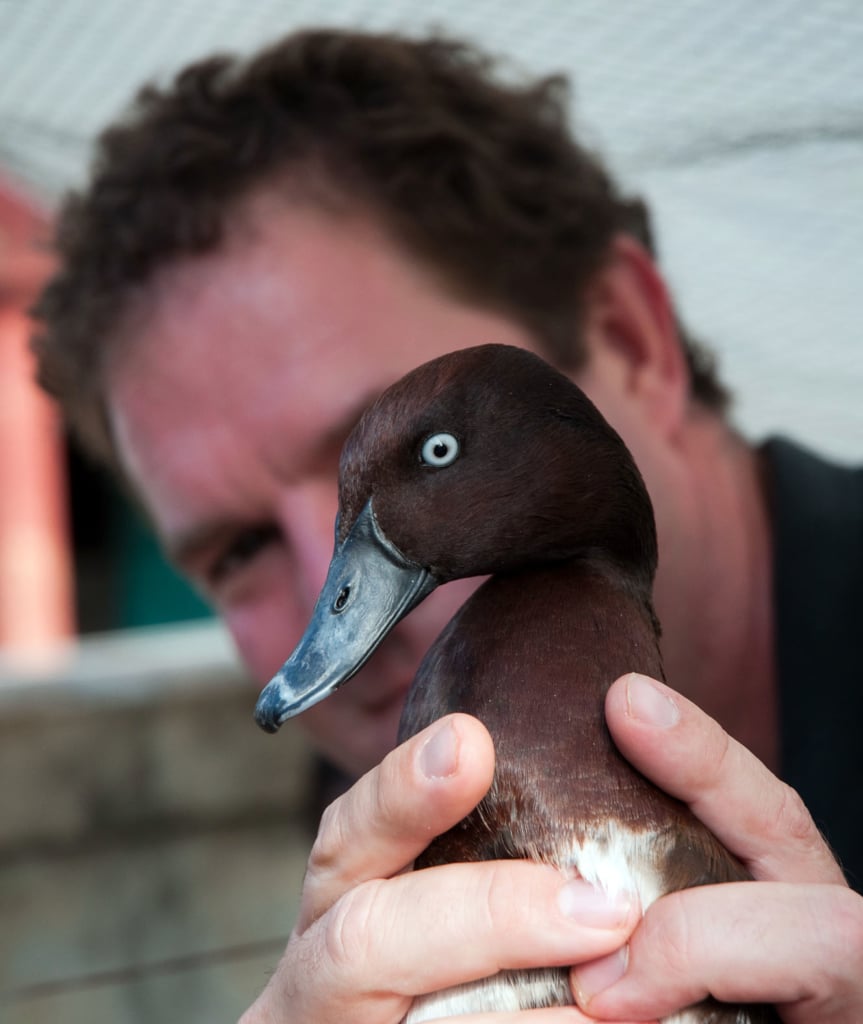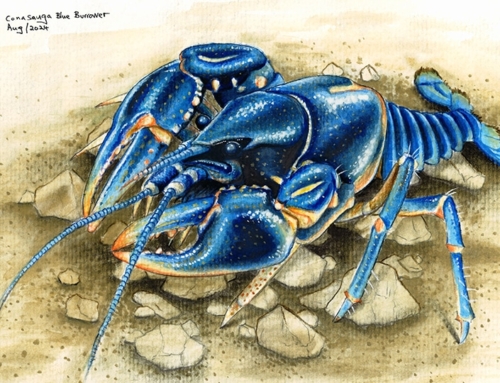The Madagascar pochard is a small, brown duck. If you saw one bobbing about on the surface of a local pond, you might not pay it much attention. It might not land a part in Madagascar, the movie. But if you look a little closer, you’ll see that the pochard is a beautiful bird – graceful and elegant with a beady eye. It also happens to be the rarest duck in the world.

Nigel Jarrett, (WWT Head of Conservation breeding) with an adult pochard © WWT
Madagascar, the fifth largest island in the world, is home to a unique collection of charismatic but highly threatened species. It makes up less than 0.5 per cent of Earth’s landmass, but contains around 5 per cent of its biodiversity. The majority of its species – more than 80 per cent – exist nowhere else on Earth. But for all its natural beauty, Madagascar also suffers from chronic poverty – around 75 per cent of its population live below the poverty line, according to the World Bank – and pressure on the environment and natural resources is intense.
The Madagascar pochard is one of its less celebrated species, but its plight mirrors that of countless others on the island, the causes often the same: slash and burn agriculture, deforestation, increased sedimentation of rivers and wetlands, pollution, invasive species and over-exploited natural resources. As habitats disappear and food sources dwindle, species populations become fragmented and vulnerable and their numbers start to decline towards extinction. But for the pochard, there is light at the end of the tunnel: a long-term collaboration has dragged them back from the brink of extinction, at the same time proving what is possible with the right combination of partnership, patience and local community participation.
A surprise discovery
The Madagascar pochard is so rare that for many years it was thought to be extinct, another victim of the ecological devastation that has ravaged vast areas of this island nation. Then in 2006, a team from US NGO The Peregrine Fund rediscovered a small population living on a remote crater lake in the north of the country. This last remaining population of ducks had been pushed out of their natural habitat and were struggling to survive. Used to finding food in shallower, marshy habitats, the depth and temperature of this crater lake meant that the young could not feed and were unable to survive. At this stage, the future looked bleak for the Madagascar pochard. With so many other charismatic species on the island under threat, what hope was there for an unremarkable diving duck?
Saving a species from extinction is not easy. It doesn’t just take a clever idea, a significant sum of money, or a committed and passionate team. Normally, it requires all of these things and more. Despite little being known about the birds – they are so rare that there has been very little scientific study carried out – our partners the Wildfowl and Wetlands Trust (WWT) and Durrell Wildlife Conservation Trust realised that without urgent action the Madagascar pochard would very soon go extinct. Taking eggs from this last remaining population, they established a captive breeding programme. 23 birds were successfully raised from this first clutch of eggs. Since that initial effort, 114 birds have been bred, more than quadrupling the initial population. The success of the captive breeding programme has even attracted some high powered visitors, among them the President of Madagascar and HRH Princess Royal.
A new home
Meanwhile, the painstaking process of finding a new home for the birds began. Since humans first set foot on the island, around 90 per cent of Madagascar’s forests have disappeared. In just the last few decades, it has lost an estimated 60 per cent of its wetlands. Sustained and unsustainable pressure on the environment has meant that much of the island’s unique wildlife has already been lost or pushed to the brink of extinction. The team had to be sure that any new home they found for the pochards was not already too degraded.
Lake Sofia, in the northwest of the country, was identified as a suitable location, so the vital work began to build relationships with local people living around the lake, bring in stakeholders including the Malagasy government, and create the right conditions to ensure that the lake would remain a viable habitat for the birds in years to come.
Over a period of around four years, some remarkable changes were seen around Lake Sofia:
- Nearly 1,000 people joined community-based management associations.
- 450 farmers got involved in sustainable rice schemes. After the introduction of sustainable rice farming techniques, rice yields increased by 300%.
- 100% of fishers began to use legal nets and initial surveys suggest their daily income has increased more than two-fold.
- Surveys suggest there was an 80% reduction in the use of pesticides across the whole catchment area.
Supporting the Madagascar pochard
Synchronicity Earth began supporting the Wildfowl and Wetlands Trust’s work on the Madagascar pochard in 2012. We have continued to support their work because we see the value in their patient approach: combining the best science with local expertise and capacity; responding to the needs of the local community; prioritising effective collaboration with other partners – both international and Malagasy – and a focus on species that would not normally get the headlines. More recently, we have also contributed funding to Durrell Wildlife Conservation Trust, another key partner in the work to save the pochard and restore its wetland home. Our support has helped to develop and trial the floating aviaries used in the release of the first group of pochards in December 2018.
Freedom at last!
With a new home identified and the foundations of a healthy habitat laid, the next step was to find the best way to release the birds into their new wild home and effectively monitor their progress as they settled in. Bespoke floating aviaries were designed for the ducks, specially adapted from fish-farming cages made by a Scottish salmon-farming outfit. These were tested on other diving ducks (at WWT Slimbridge), which took to them well, so the team were confident that they could be effective in situ. Radio tags were also made to be fitted to the ducks to allow monitoring as they were released.

Lake Sofia, a new home for the Madagascar pochards © WWT
Then, in December 2018, a landmark moment: 21 birds were released on to the lake. The team had planned for this moment down to the very last detail. Given the difficult road conditions, they had even put in place a contingency plan to take the ducklings to the lake by helicopter, should the roads prove impassable. Fortunately, there was no need for an early taste of life in the air for the ducklings. On arrival, the birds were checked in to aviaries which had been built by the shore of the lake, giving them time to recover after the arduous road journey and before the release could begin in earnest.

The first birds being released into their new home on Lake Sofia © WWT
It is early days, but initial signs are good: the birds that have been released back into the wild seem to be doing well. Only time will tell whether the population of Madagascar pochard is able to recover and thrive in the wild, but for a bird that was once thought extinct, the future looks a little brighter.
When the Madagascar pochard was rediscovered, its chances of survival looked slim. How would a seemingly unremarkable bird stand a chance if more celebrated species were not getting the attention they needed? Yet through a combination of the right partners; effective teamwork; ingenuity; long-term support and funding and conservationists and community working together, this species has been brought back from the brink in one of the most challenging environments on Earth. The benefits have been felt not just by the lake and its species, but also by its people. In a country that faces some of the most severe and urgent environmental and developmental challenges on Earth, the story of this small brown duck serves as an inspiring example for others working in Madagascar and beyond to save some of our planet’s extraordinary wildlife.
Do you want to contribute to conservation for people and planet? Find out more about our Programmes and the partners we support, or DONATE.
Watch a short film about the Madagascar Pochard’s release below:





